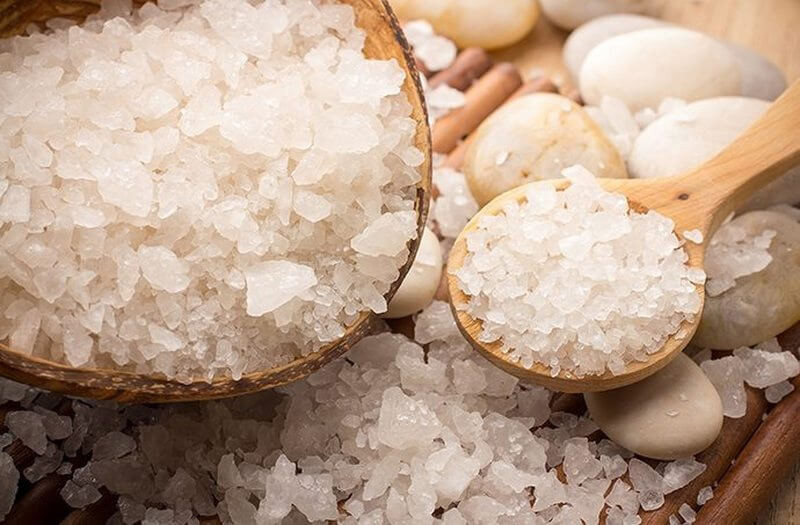Reviewed By: Kacie La
Feel like taking a break within the comfort of your own home? Then add bath salts next time you jump in your tub and you’ll see how refreshing the experience is – turning a necessary activity into some time out for yourself.
Bath salts come in different types, scents, colours and shapes. Sometimes this can be confusing, so we’ve put together this useful guide to help you decide which bath salt suits you best, outline the benefits of using them and include a couple of DIY recipes, so you can start enjoying them as soon as possible!
There are two main types of bath salts we will focus on: Epsom and Himalayan.
Epsom
Epsom salt, named after a bitter saline spring in Surrey, England, is not actually salt but a natural mineral mix of magnesium and sulphate.
These salts have been used by a number of cultures for hundreds of years, and possess different beneficial properties.
Benefits
When Epsom salt is used in a bath, your body will absorb magnesium, which helps in regulating the activity of several enzymes. Sulphate will also improve the absorption of nutrients and can assist your body with the elimination of toxins, via reverse osmosis.
Uses
Epsom salts are especially useful for beauty purposes. When you are in the shower, mix a handful of salt with olive oil and rub it over your skin, to exfoliate. If you want to clean your face, mix a handful of salt with your regular face wash and massage gently.
To experience all the benefits of Epsom salts, have at least three baths per week, adding about 2 cups of salt to warm water. If you would like to further smooth your skin in the process, you could add half a cup of baby oil. Remember to never use soap while using Epsom salt as it might interfere with the action of the minerals.
Another idea is to soak your feet in water with half a cup of Epsom salt for about 20 minutes. You can also rub any calluses using pumice powder. Your feet will look fresh, clean and much more beautiful!
Himalayan
Himalayan salt is actually salt, which does not come from the ocean, but the Himalayas (hence the name). This type of salt is better in quality than traditional iodised salt, considered the purest on earth and millions of years older. Because it has been maturing over the past 250 million years, surrounded by snow and ice, it has remained untouched by many of the toxins and contamination that ocean salt has.
Himalayan salt contains 84 natural minerals found in the human body, and its uncommon cellular structure allows our cells to easily absorb its properties. It is hand mined from the mountain range.
Benefits
The use of Himalayan salt may bring several benefits, including help in regulating the water levels within the body and reducing signs of ageing.
Uses
For detoxifying, add a cup of Himalayan salt to your bath and stay no less than 20 minutes. The nutrients stimulate blood flow, making it easy for your body to absorb the 80 nourishing minerals that Himalayan salt is composed of.
DIY recipes
We’ve put together five DIY bath salt recipes plus one instant extra moisturising bath recipe so you can start enjoying your own natural baths in the comfort of your home.
Lavender aromatherapy bath salt

You’ll need:
- 4 cups of Epsom salt
- 1 cup of Himalayan salt
- 5 drops of red food colouring
- 5 drops of blue red colouring
- 30 to 40 drops of lavender essential oil (aromatherapy oil)
- 1 cup baking soda
- 3 tablespoons dried lavender
Method:
- In a large metal or glass bowl, mix the salts
- Add the food colouring and the lavender oil, while stirring
- Add the baking soda
- Add the dry lavender and mix gently
- Store in a glass air-tight container
Mojito bath salt

You’ll need:
- 2 cups of Epsom salt or Himalayan salt, as per your preference
- Fresh diced mint
- Juice and zest of a lemon
- Peppermint oil
- 3-5 drops of green food colouring
Method:
- In a small metal or glass bowl add the salts
- Add the mint and lemon juice and zest, stirring gently
- Add the green food colouring
- Mixed thoroughly until the fragrance and colouring all well combined
- Store in an air-tight container
Lemon rosemary bath salt
You’ll need:
- 2 cups of Epsom salt
- ½ cup of baking soda
- 2-3 tablespoons of dried mint, lavender, rose petals and chamomile
- 6-8 drops of lemon essential oil
- 2-3 tablespoons of lemon zest
Method:
- In a metal or glass bowl mix the salt and the baking soda
- Add half of the lemon essential oil, mix, and then add the rest
- Add the chopped rosemary and lemon zest, mixing carefully
- Store in a glass air-tight container
Herbal bath salts

You’ll need:
- 2 cups of Epsom salt
- 1 cup of Himalayan salt
- 2-3 tablespoons of fresh finely chopped rosemary
- 8-12 drops of unscented essential oil
Method:
- In a metal or glass bowl mix both salts together
- Add the essential oil and stir gently to distribute the oil
- Pour the mixture into a glass container and top it up with the dried herbs
- Store it in an air-tight container
Milk, honey and salt moisturising bath

You’ll need:
- 1/2 cup of Himalayan salt
- 2 tablespoons of baking soda
- 1 cup of boiling water
- 1 cup of honey
- 2 cups of milk
- 10 drops of vanilla oil
Method:
- Dissolve the Himalayan salt and the baking soda in the bathwater
- Dissolve the honey in the cup of boiling water and then mix it with the milk
- Add the milk-honey mixture to the bathwater
- Mix it around with your hand and jump in!












